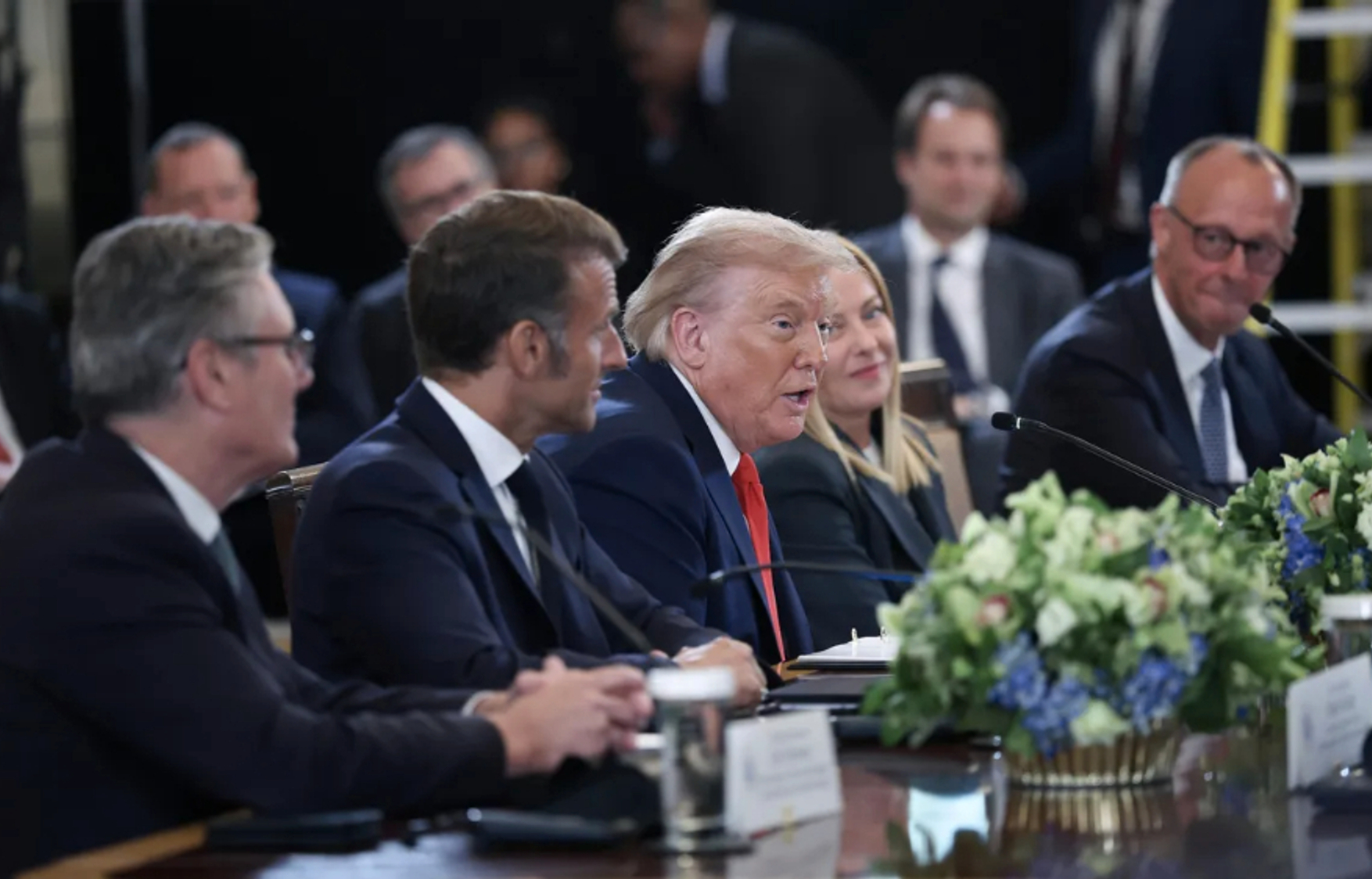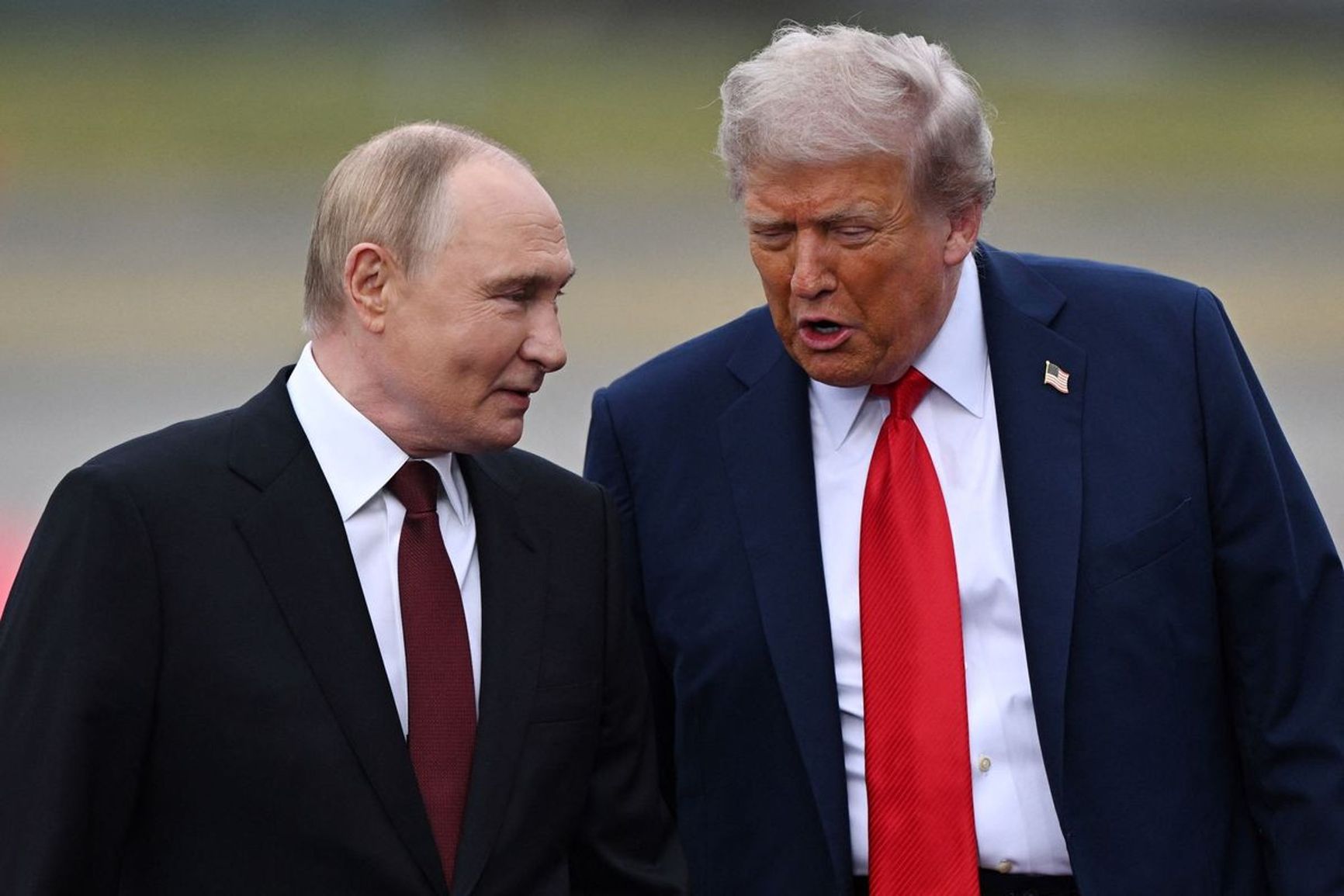
Joining Donald Trump and Volodymyr Zelensky in Washington were the head of the European Commission, the NATO Secretary-General, the presidents of France and Finland, and the prime ministers of the United Kingdom, Germany, and Italy

Joining Donald Trump and Volodymyr Zelensky in Washington were the head of the European Commission, the NATO Secretary-General, the presidents of France and Finland, and the prime ministers of the United Kingdom, Germany, and Italy
Trump is fast-tracking preparations for a meeting between Putin and Zelensky, Europeans are holding consultations on a daily basis, the Russian commander-in-chief is calling other heads of state to brief them on his talks with his U.S. counterpart, and even the Pope has urged that August 22 be declared a day of prayer for peace in Ukraine. After their abortive get together in Alaska, it seemed that Putin had once again succeeded in manipulating Trump, notes Ukrainian analyst Georgiy Chizhov, head of the Center for Reform Assistance. But as negotiations unfold, Trump is leaning closer to Europe, and U.S. policy has become far less accommodating toward Russia than it was just six months ago.
Before brief U.S.–Russia talks of Aug. 15, their significance had been — deliberately or not — inflated by all sides. Trump, true to form, hinted that his peacemaking mission was on the verge of achieving total success. Putin convened his Security Council on camera, evoking painful associations with a similar conclave that was held on Feb. 21, 2022 in the run-up to the full-scale invasion of Ukraine. The Ukrainian side loudly voiced its concerns, which essentially boiled down to the fear that Trump would fall under Putin’s sway, striking a deal on Russian terms and halting support for Kyiv in the event that Zelensky refused to comply in full.On the eve of the U.S.–Ukrainian meeting that took place on Aug. 18, yet another concern was added to the list: when Zelensky entered the Oval Office for the first time since the infamous incident of Feb. 28, would Trump belittle his guest once again — this time with potentially dire consequences for the Ukrainian war effort?
Fears about what might transpire if Zelensky were left to face the Trump administration one-on-one may well have been the key reason European leaders arrived at the White House. After all, the group was wryly dubbed by Ukrainian journalists as the “therapists team,” tasked with calming the American president should tensions threaten another outburst.
As for the political analyst class, they had predicted even before the Russian and American teams departed for Alaska that nothing of real consequence would come out of the meeting. And for the most part, they were right.

The fears materialized only in part. Donald Trump indeed yielded — once again — to the rather dubious charm of his counterpart. The outcome was team America’s withdrawal of its thirty-day ceasefire proposal (long touted as a firm U.S. demand), its refusal to impose secondary sanctions on Russia’s trading partners, its stated willingness to concede to the Russian army Ukrainian territories not yet under the control of Moscow’s forces, and its declaration that Zelensky alone bore responsibility for the future of war and peace.
“I think he wants to make this deal for me, you know? However crazy that may sound,” Trump was recorded telling French president Emmanuel Macron in the White House on Monday, speaking about Putin. The remark, needless to way, shows a certain disorientation on the part of the U.S. president.
I think he wants to make this deal for me, you know? However crazy that may sound
Nevertheless, the not entirely explicable fascination that the world’s most powerful man seems to have with the Kremlin autocrat did not lead to the disaster that the pessimists had foretold. True, Vladimir Putin evaded the ultimatums, as he has done in the past, but the Trump of today is not the Trump of last winter or spring, who was utterly unwilling to accept any pushback from the heads of democratic states.
Apparently, in the past half year, the U.S. president has learned more about the rules of international diplomacy than he did in the entirety of his first term. For instance, he now states that the issue of territorial concessions can be decided only by the Ukrainian people and President Zelensky.
In the end nothing disastrous happened. Ukraine was neither betrayed nor sold out. But did the talks yield a decisive breakthrough? Unfortunately, no. The sense of euphoria that followed the Washington summit — fueled by the fact that world leaders were already discussing the framework for security guarantees for Ukraine after the war — quickly ran up against one obvious reality: nothing substantial can be done without buy-in from Moscow.
Unfortunately, the Kremlin has rejected virtually every proposal put forward by Ukraine, Europe, and the United States. It refuses to freeze the front line with limited “proportional” territorial exchanges; it will not renounce its dubious legal claims over the Ukrainian lands annexed by Russia; and it adamantly opposes any suggestion that security guarantees for Ukraine take the form of NATO troops stationed in the country, or even of bilateral treaties like those the U.S. has signed with Japan and South Korea. It even says no to a direct meeting between Putin and Zelensky — with or without Trump present.

In this context, theRussian dictator’s offer to host the U.S. and Ukrainian presidents in Moscow should be seen as little more than a barely concealed refusal to meet with Zelensky, who could not plausibly set foot in the country that continues to attack him. Trump, after all, could still make a trip to Russia — the rules don’t seem to apply to him, and American officials continue to project optimism and are preparing either a bilateral or a trilateral encounter. Friedrich Merz has claimed that Putin is ready for a personal conversation with Zelensky. Yet so far, there are no solid grounds to believe such a meeting will actually take place anytime soon.
According to another optimist, Trump’s special envoy Steve Witkoff, Putin was even ready to discuss Western security guarantees for Ukraine modeled on Article 5. Yet sources cited by Axios say the presidents did not agree on any concrete mechanisms, and that Putin, when speaking of potential guarantors, mentioned China rather than Western nations. Meanwhile, Russia’s Foreign Ministry — through spokeswoman Maria Zakharova — made its opposition to any NATO troop deployment in Ukraine after a ceasefire perfectly official.
The positions of both Russia and Ukraine remain largely unchanged from last fall, back when Trump was still only the President-elect, but the few seemingly minor shifts are nevertheless significant. Zelensky is ready to acknowledge Russia’s de facto control over the territories it occupies and also to renounce any attempt by Ukraine to retake them by force. However, at this point there is virtually no room for him to retreat further, as accepting any of Russia’s further terms would spell irreparable damage both to his country’s independence and to his own political future. Even a continued withdrawal of the Ukrainian army at the pace seen so far appears to be the lesser evil.
Moscow, which at first glance seems to have more room to maneuver, still flatly refuses to soften its demands. True, Putin has reportedly agreed to drop claims on the parts of Kherson and Zaporizhzhia regions still controlled by Ukraine — but only in exchange for a complete withdrawal of Ukrainian forces from Luhansk and Donetsk. In Kyiv, however, such an offer is seen unequivocally as a military-diplomatic ploy.
Even after a series of localized Ukrainian withdrawals, the defensive lines in Donetsk remain a tough nut for the Russian army to crack, with battles likely to drag on for many more months, if not years. As for the Kremlin’s supposed readiness to relinquish Kherson and Zaporizhzhia, it is difficult to take such claims seriously: in the Russian Federation’s own constitution, the “new regions” are enshrined under the names of their regional capitals — cities that are still outside the control of occupying forces.
And yet, it would be unfair to ignore Donald Trump’s hyperactivity. His controversial, inconsistent, and at times chaotic efforts have indeed shattered the inertia that had long surrounded diplomacy on the Russia–Ukraine war. Since the beginning of 2025, more and more heads of state have joined the search for compromise between the warring sides. Their motivations vary: some simply fear that an “unsupervised” American president could wreak havoc, while others recognize that Europe, left without its “big brother,” must now make extraordinary efforts to preserve its own political influence.
Trump's controversial, inconsistent, and at times chaotic efforts have indeed shattered the inertia that had long surrounded diplomacy on the Russia–Ukraine war.
Meanwhile, Putin is doing everything he can to sideline the Europeans — betting that Trump, with his impulsiveness, contradictions, and well-documented readiness to yield to the Kremlin strongman, will fail to carry the burden of a peacemaker and ultimately ease Moscow’s path to a final solution to the Ukrainian question.”
The only real levers the collective West still has involve the stricter enforcement of sanctions, the rollout of additional sanctions (though there's not much room left for creativity), and the strengthening of Ukraine’s armed forces with new weapons supplies and expanded military training.
It is clear that not only Ukraine, but Russia as well, has been deeply worn down by the war. Yet nothing short of the realization that the West once again stands united can compel Moscow to accept a genuine compromise. In this sense, the emergency gathering in Washington may, in the long run, help forge common positions and approaches — provided, of course, that Trump finally abandons the illusion that the future of the world can be fixed through a “deal for two.”
К сожалению, браузер, которым вы пользуйтесь, устарел и не позволяет корректно отображать сайт. Пожалуйста, установите любой из современных браузеров, например:
Google Chrome Firefox Safari